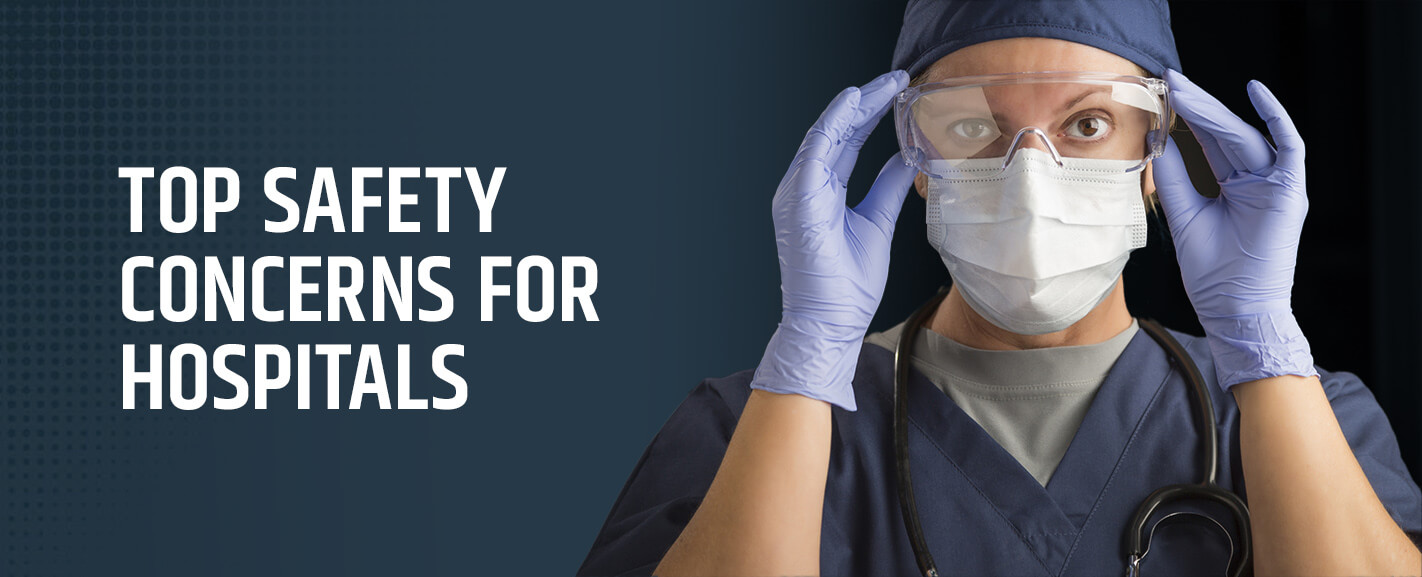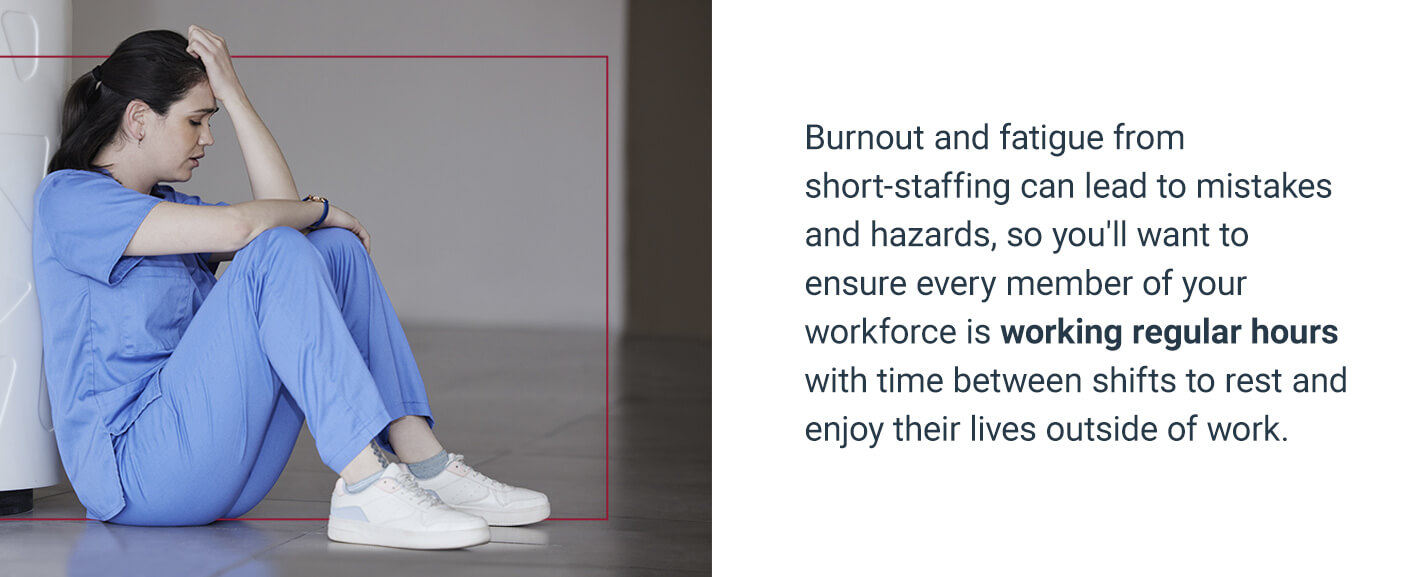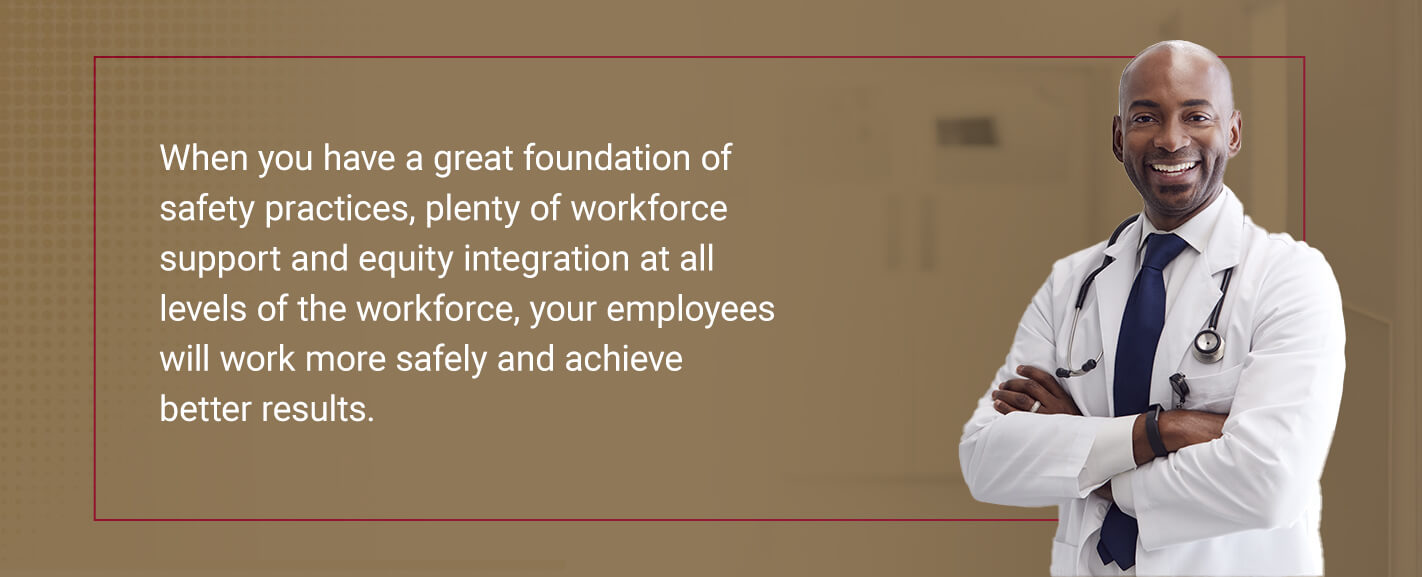Top Safety Concerns for Hospitals

Hospitals are robust and multifaceted workplaces where patients require operations, diagnoses and transportation. Meanwhile, the hospital staff maintains a tight and busy schedule to ensure smooth functioning. With food getting delivered and medications getting administered around the clock, hospital workers do a lot to meet the needs of every patient in the building.
But every worker on premises also has needs of their own when it comes to their health and well-being. As a safety professional in the healthcare industry, it’s your job to make sure your hospital is safe for every employee and patient. Here, you can learn about some of the top safety concerns for hospitals, along with techniques for preventing hazards in hospitals.
5 Safety Concerns for Hospitals
Knowing what you and your employees are up against when it comes to health and safety is the first step toward cultivating a safer working environment. There are many contributing factors to hospital workplace safety that, if neglected, can put people at more risk. Conversely, investing the proper resources into these same areas can help your hospital become a much safer place for workers and patients alike.
In this section, you can learn about some of the main safety issues for hospitals that you and your team will have to address on a daily basis.
1. Foundational Safety Measures
It would be unwise for a contractor to try to build a new room over a faulty foundation. The foundation must be firm and secure for the rest of the house to stand. The same can be said of the overall safety of a hospital. Proper foundational safety is essential for any future safety framework to function. Unfortunately, the lack of proper foundational safety measures puts many hospital workers at risk.
Make sure your hospital has a strong foundation when it comes to workplace safety. A strong foundation starts with the culture of your workforce. You must establish and strengthen a culture of safety throughout the entire organization. The culture of safety must be strong enough to persevere even during the most difficult times — like during a pandemic. A strong foundation of safety will increase the chances of workers following proper safety measures and protocol, even during the most stressful of healthcare seasons.
A strong culture of safety encourages the workforce to speak up when they feel that something is wrong with safety measures. Every worker should be comfortable and confident enough in their safety system to report hazards and potential safety errors without fearing the consequences.
Proper training should be a part of every employee’s onboarding experience. Even continual safety training workshops and online certificate testing can help keep a culture of safety alive and prospering within a hospital’s workforce. Regardless of what’s happening in the hospital at any given time, the workplace will be safer when employees have received proper training. From there, an authentic workplace culture of safety is achievable.
2. Workforce Support
Every hospital worker needs a support system to keep them accountable and cared for. Part of making intentional efforts to support and protect your workforce is giving them a workplace that keeps them physically safe. But beyond this, you also need to invest in the psychological and emotional safety of your workforce. Well-being, joy and happiness all play crucial roles in how your workers feel during the workday, which can translate to how safely they complete their tasks.
Workers who feel alone or like they lack lines of communication and support will be at a higher risk of making mistakes and working despite unsafe conditions. They may also lack the energy or enthusiasm to notice potential hazards or perform proper safety procedures to reduce their risk of experiencing a hazard, which increases the chances of harm occurring in the hospital workplace.
Another important aspect of workforce support is ensuring you have enough people on staff at any given time, especially during peak hours. Burnout and fatigue from short-staffing can lead to mistakes and hazards, so you’ll want to ensure every member of your workforce is working regular hours with time between shifts to rest and enjoy their lives outside of work. You’ll need an adequate number of people on your payroll to fill each shift and spread the workload evenly.
3. Equity Integration
Many hospitals are also facing the safety concern of a lack of equity integration into their daily routines. Equity in this context refers to the normalcy and repeatability of tasks to reduce mistakes and ensure consistent results. In other words, your hospital’s structure of various tasks should be equal from one time to the next.
Your goal as a safety professional should be to ingrain and emphasize health equity into each employee’s work tasks. As workers repeat tasks and accomplish their to-do lists for the day, they should have a solid framework to follow that includes proper safety practices along the road to quality outcomes.
When employees face unwanted or unexpected variations — or inequities — to their systems, safety risks could arise. Employees may feel less confident in their abilities as they navigate uncharted territory. They may also have to pay more attention to the new instructions, causing them to forego safety measures, putting themselves and their patients at heightened risk of harm.
Find those areas of your workforce where employees consistently report safety breaches. Invest time and resources into integrating equity into their workflow so they can better predict what happens next, being sure to include safety procedures in every step of their process. By ingraining safety procedures into every department’s workflow, you can ensure equity integration that leads to better, safer outcomes.
4. Diagnostic Harm
One of the most critical safety concerns every hospital faces is diagnostic harm, which is a phenomenon that stems from diagnostic inaccuracy. Diagnostic harm occurs when healthcare professionals misdiagnose a patient or perform an operation based on a misdiagnosis. Misdiagnosis can also involve avoiding a certain procedure that should have been conducted based on a misdiagnosis. Whatever the case, the patient is the one that first suffers diagnostic harm. The hospital can suffer reputational and financial harm in the aftermath.
There are many contributing factors to diagnostic harm, including the following:
- Chaotic work environments
- Peak hours
- Staffing shortages
- Fatigue
- High clinician stress levels
Missed diagnoses, delayed diagnoses and improperly communicating diagnoses to patients are all examples of diagnostic inaccuracies that can lead to harm. While it can be difficult to find accurate data on how your hospital is performing in terms of diagnostic accuracy, you can take measures to ensure your workforce avoids the contributing factors to diagnostic harm listed above. Avoiding these factors will give your workforce the best chance at diagnostic accuracy, happier patients and less harm experienced for all involved parties.
Many hospital safety concerns stem from having a poor foundation of safety practices, which is especially true when it comes to diagnostic harm. However, it also ties into equity integration and workforce support. When you have a great foundation of safety practices, plenty of workforce support and equity integration at all levels of the workforce, your employees will work more safely and achieve better results.
5. Healthcare-Associated Infections
Patients expect hospitals to be safe, sanitary places where they can recover from sickness, injury or other conditions. It’s the workers’ job to maintain an environment that is conducive to healing and wellness for patients while ensuring the safest work environment for every employee. Yet maintaining a safe work environment can be a full-time job in itself, which is why equity integration and foundational safety measures are so important. These steps help keep patients and workers safe despite the potential hazards of healthcare scenarios.
Although hospitals throughout the United States offer high-quality care in a safe environment thanks to essential regulations from the Occupational Safety and Health Administration (OSHA), hospitals are still susceptible to unplanned safety breaches. After years of steady decline, a recent study found that healthcare-associated infections (HAIs) increased in 2020. While the increase may have had something to do with pandemic-related issues, it shows that workers and patients in hospitals still face safety risks in the form of infections and contaminations.
You must assess your hospital’s infection prevention programs to find areas that are succeeding and those that need improvement. Ensure you have the right amount of resources and workers to protect staff and patients alike. Surveillance and process reporting are two other ways you can help bolster your processes and ensure workers are following protocols to avoid HAIs.
Potential Safety Hazards in Hospitals
Besides the five general safety concerns above, hospital workers also face specific safety hazards that they need to be aware of if they are to avoid them. Understanding what safety hazards workers can face in a given day or particular situation will help them mentally and physically prepare to avoid these risks and reduce harmful outcomes.
Here are some of the main safety hazards for hospitals you should know about:
- Occupational infections: Hospitals are an environment for helping people recover from illnesses and injuries, which puts hospital workers at risk of contracting infections like hepatitis B and C, HIV, AIDS, tuberculosis and various respiratory infections.
- Unsafe patient handling: Moving, repositioning, transferring and lifting patients is a potential hazard if workers fail to use the right techniques when doing so. Proper lifting technique also applies to handling heavy equipment while on the job. Poor technique can lead to skeletal injuries and chronic back pain.
- Hazardous chemical and material exposure: Hospital work involves various hazardous substances that can be harmful without proper handling. Hazardous chemicals and materials include disinfecting agents, mercury, sterilants, pesticides, toxic drugs, latex, laboratory chemicals and bodily fluids.
- Radiation exposure: Several forms of radiation exist in hospitals, including ultraviolet, lasers, radionuclides and x-rays. These forms of radiation pose unique risks to the safety and health of administering staff and require specific protocols for safe usage.
- Stress, fatigue and burnout: Because of the nature of their job, healthcare workers are susceptible to burnout, fatigue and stress due to moral injury, lack of support, long shifts, a lack of control over work tasks and time pressure.
- Violence and harassment: Unfortunately, work-related assault, threats and abuse can occur for healthcare workers and may involve psychological, verbal, sexual and physical abuse and harassment.
- Ambient risks: Ambient risks include factors like extreme noise levels and thermal discomfort. These can occur in the hospital workplace like any other workplace and can influence the overall well-being of employees.
- Environmental health hazards: Hospital employees may face environmental safety hazards, including insufficient water for washing and drinking, a lack of sanitation resources for proper hygiene or hazardous climate and waste-related risks. These can contribute to the contraction of injuries and diseases among healthcare workers.
- Occupational accidents: The job of a healthcare worker puts people in close contact with several risks that can lead to injury. These include slips, trips, road traffic, falls, explosions, fire, electric shock and shapes injuries.
Benefits of Worker Safety in Hospitals
Proper worker safety frameworks and preparedness are important in hospitals and every workplace. Here are some of the benefits of investing in workers’ safety at every level of the healthcare sector:
- A safe family of colleagues: As time goes by and experiences come and go, a hospital workforce can become a family of its own. People work together to attain goals, even if they occasionally rub each other the wrong way. Everyone comes together for the betterment of the patients. Safety is key to making this possible. With safer practices, your workforce can stay healthy and ready for action, helping each other every step of the way.
- Lower workers’ compensation costs: Fewer injuries equals lower workers’ compensation costs, meaning your hospital can save more money every year to put toward other areas of the budget.
- Greater patient safety and outcomes: Greater worker safety translates to better patient outcomes and overall safety. When workers are healthy, vibrant and ready for their tasks, they will be better able to provide care and support to patients, leading to better patient outcomes and increased health throughout the hospital.
- Better hospital reputation: Better patient outcomes will translate to a better reputation for your hospital. You’ll have more satisfied patients and workers who stay healthy and confident throughout their careers at your hospital. All these factors combine to a better experience for everyone who walks through your hospital’s doors.
Purchase NASP’s Certified Safety Manager for Healthcare Course
The National Association of Safety Professionals (NASP) has the online safety courses you need to advance your career and ensure your hospital is a safer place for workers and patients alike. By achieving your safety certificate online, you can gain the knowledge you need to foster a safer working environment to achieve the benefits listed in this article.
Read more about our Certified Safety Manager for Healthcare (CSMH) course, or contact us today with any questions or to take the next step toward your professional safety certificate.
Purchase Our Certified Safety Manager for Healthcare (CSMH) Course
Related Posts








